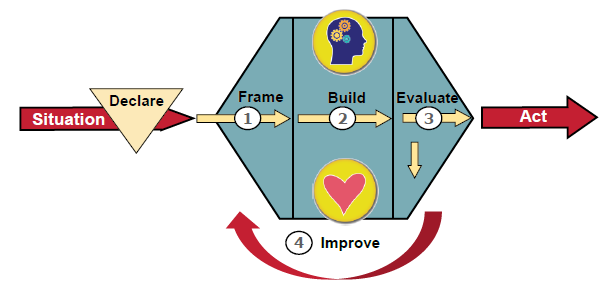Process for Making Quality Decisions
However, a good decision process will help us to face whatever it is that is most important in reaching the best choice, even if it takes effort or feels uncomfortable.
I Really Want to Get This Right
The way we go about making a decision may shape our ultimate choice, and our preferences and biases influence our decisions. However, a good decision process will help us to face whatever it is that is most important in reaching the best choice, even if it takes effort or feels uncomfortable.
With a good process, we can address the components of a decision in a sensible order and make a decision in a timely manner. Further, such a process helps us achieve the appropriate balance between considerations of head and heart, between searching for facts and creating possibilities, and between deciding too quickly and taking too long to decide.
To determine the best order for building the six elements of DQ, generally, start with frame because, if the frame is not right, the rest of the steps may be useless. The order of building information, values, and alternatives is not important. These elements interact—e.g., the information we need depends on the alternatives we consider. We arrive at DQ by cycling through the decision process until there’s no more value to be gained in any part.
The sidebar presents a basic four-step process that is appr15opriate for most decisions made by individuals. At the end of the booklet, we also describe a process that has been shown to be very effective in generating alignment around a quality decision in a large or diverse group.
HOW TO COMMIT TO FOLLOW THROUGH
After declaring a decision, go through four steps.
1. Frame: Make sure to solve the right problem. Determine the purpose, scope, and perspective for the decision.
2. Build: Engage in working on the problem and improve the DQ links. Develop alternatives, get better information, and get clearer about what you really want.
3. Evaluate: Compare and evaluate the alternatives based on information and values—which is best for me and for those I care about? Before reaching closure, test the quality of your decision. Rate the decision on each element. Does the choice make sense and feel right?
4. Improve: Identify and fill gaps to bring the quality of your decision to 100%. Then proceed to committed action.
Balance the process between heart and mind.
• Consider the head and heart in each step.
• Get the facts and create possibilities.
• Don’t skip the initial steps or get too bogged down.
TOOLS AND GOOD PRACTICE
• The four-step process
• The DQ checklist
• The Decision Rating
• Know my personality type and which process parts I would emphasize or miss
• A coach
TRAPS TO AVOID
Doing only what comes naturally, following our preferences or biases
• Viewing the problem from the perspective of only the heart or the head
• Doing it alone (without a coach, we are tempted to skip steps)

